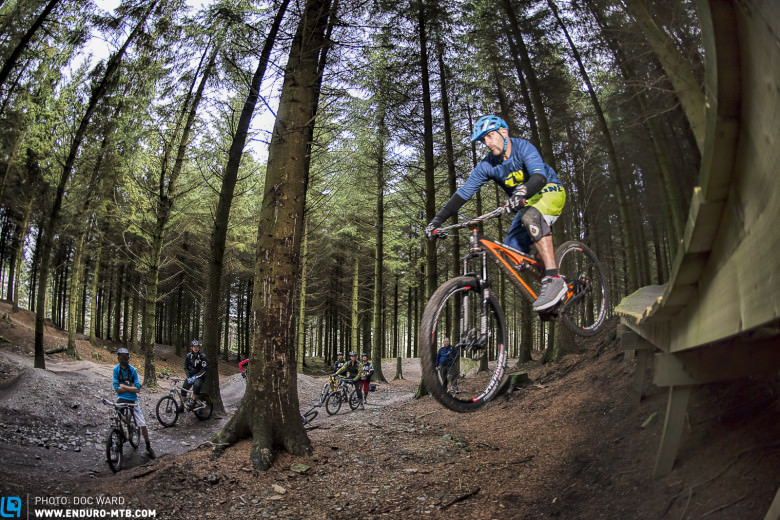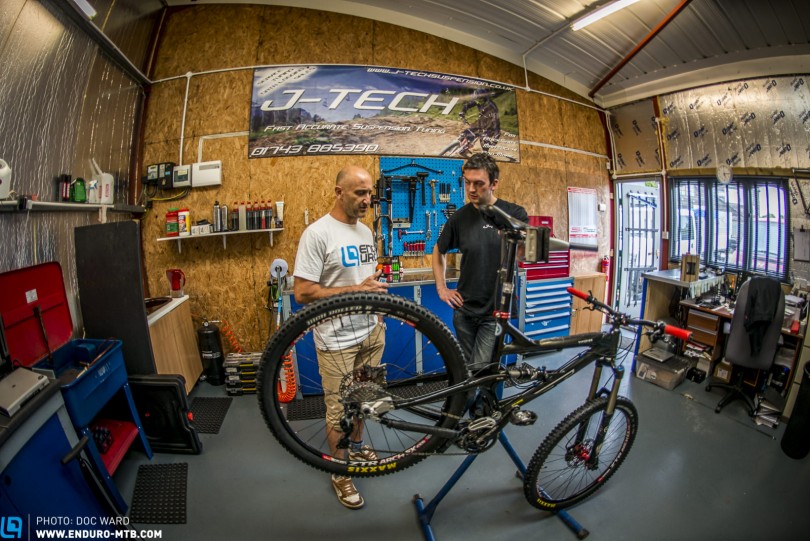In this new world of mega-technology, everything is moving on at a massive rate of knots when it comes to bike development, talk of electric gears, blue-tooth dropper posts, light but mega-strong carbon wheels and all sorts of linkage designs now coming out of the woodwork. When it comes to riding fast, be you a racer, trail demon or purist off-piste adventurer, there is one massive factor that makes a huge difference, but lots of riders still don’t understand, correct suspension set-up.

I personally consider myself (like many) to be a layman suspension setter, I know roughly the right amount of sag, how fast the shock or forks should return after a good hard push down. Plus I usually know when I have a go of a bike if someone really doesn’t have a clue about suspension, with rebound either like a pogo-stick or returning at the speed of an over-booked Ryan Air flight! I have always got a tad baffled about compression damping though and when it comes to my new test shock, the Cane Creek DB Air CS, with its twin rebound and compression adjusters, I have to admit I was truly stumped.
I had mine on the base settings, but after messing about with it then pumping in the right amount of air for the correct sag, it just felt rock solid on the big hits, plus my Rock Shox Pikes seemed to bust through their travel and needed the volume reducers fitting. The latter was a simple three-minute job, but as for the proper set-up, it was time to visit J-Tech and talk to James, to try and make sense of the whole thing.

So James, the problem I have here is I find I’m having to run too much sag, as with the correct amount it just feels too stiff?
It sounds to me like you have too much compression damping for a start.

I hadn’t touched it from new, but after a trip to a trail full of jumps I found the back end to be kicking a bit, so I tried to slow down the rebound, there were two adjusters and I seemed to make things worse. Plus the forks have had the extra two volume reducers in, which has sorted out the diving into the travel issue, but on tiny bumps, they seem a bit stuttery, what adjustment will sort that?
It’s definitely compression damping in both forks and shock.
(James has a fiddle with the forks, adds some clicks to the compression and rebound levers)
So I have increased the compression and rebound damping, because the forks are basically doing more work than they need to be doing. With damping the principle goes like this- Say your stood up and I push you steady and you don’t know it’s coming, you will be moved out of the way, but damping is kind of like letting you know it’s coming, then when you know you’re going to be pushed you can stand your ground, as it slows the force down. But if you go too much damping it’s just going to kick back through the bars, so you’ve just have to hit that ‘sweet spot’ in the middle ground.

Can you explain the difference between high and low speed rebound.
Yes, well basically to start with, for rebound, low speed is the speed at which the shock is constantly moving, it’s kind of equal to the amount of force that’s pushing it back, so the further you’re into the travel the more pressure you have pushing the shock back. So with the more force the shock is compressed, the faster it will try and return. Low speed, as a general rule of thumb will only control the first quarter of the travel, because there’s not as much force acting against it to shift it back faster. So that’s what your low speed adjuster is for, the more its wound in, the slower it will return. High speed is further into the travel, where there’s more spring rate or air pressure to pushing back against it, like popping off jumps or hitting big bumps you’re going deeper into the travel. So if you go faster on the high speed rebound it will give you more pop, but obviously you don’t want too much, because it will buck you off. On the other hand you don’t want it too slow, as when you come into deep braking bumps it can’t return fast enough to fully absorb the next braking bump, as it will pack down so you will start losing travel. This is where you look to hit that ‘sweet spot’ again.
So I guess the compression damping is like the opposite of that then?
Hmm, not as such, because compression (as opposed to rebound) hasn’t got the spring working against it. Low speed compression is literally that low speed movement, like pedal induced movement, or pedal bob.
So is it like the old fashioned pre-load then?
No, because pre-load just increases the spring rate by compressing the spring down, that’s what you have to think about with damping, it either speeds everything up or slows it down. So the more low speed compression you’ve got, the more stable the bike will be on faces of jumps and pushing into corners, it just gives you more support. So it won’t blow through the travel easily; if you have it too soft, you’ll loose speed and energy. If you’ve got it too soft it’s going into the travel too quick and you’re just losing all your energy that you’re putting in. You want to have it firm enough that you’re gaining speed, but not so firm that it starts losing you grip. You’ll find that on slightly rough, flat turns you might find that it’s not absorbing everything and it’s losing grip. So high-speed compression is all about when the shock moves at a high speed, so when you hit a square edge or even a root, the wheel’s got to move up at a fast rate, when you hit into that part of the travel at a quick rate, that’s your high speed compression. So if you’ve got too much high-speed compression when you hit a big square-edged bump, it will kick the wheel back without using the full travel and it will feel too harsh. If you haven’t got enough it will blow through the travel too easily, you’ll absorb it a lot, but it will kind-of over absorb it. The same with the forks really, if it’s over compressing, the bike’s becoming un-stable, it’s a case of getting the ideal balance points to create the perfect ride.

(At this point James set to work putting some base settings on the bike once I had sat on it a few times to set the sag, James uses the micrometer rather than the rubber band to set the exact amount)
So what exactly does the climb switch do then?
Basically what that does, is shuts of the low speed flow, it puts low-speed compression and low-speed rebound to maximum slow, it’s as simple as that, so it only goes through the high-speed valves for climbing. It will give you more support and the idea is, say on a Fox shock for instance, when you put your Pro-Pedal on, it will slow the compression down, but not the rebound. When you’re going up a rough climb the rebound speed’s still quite fast, so the shock extends but still has to come back to sag point, so that’s where you lose energy. With this shock it also slows the rebound down, so you lose less energy, plus it gives you a little more grip as well.
Have you had many dealings with these Cane Creek DB Airs?

Yeah, I have got one myself, it’s a real good shock, it just needs a bit more time to set up, but once you’ve got it set up, there’s no better shock really.
At this stage James was done, he had set the sag (always do this with the climb lever switched off) then set other adjusters somewhere near the base setting. He told me, with this shock, not to bother adjusting it too much now, even opting for the climb lever on smoother, more pedally tracks on the downhills as well. The following weekend I was over to do my uplift day, the difference was amazing, I never touched it once, just like he advised, and as the day went on, my confidence grew, it really did make me realize the importance of proper set-up.
Big thanks to James at J-Tech www.j-techsuspension.co.uk
Words: Jim Buchanan Pics: Doc Ward, Jim Buchanan
Did you enjoy this article? If so, we would be stoked if you decide to support us with a monthly contribution. By becoming a supporter of ENDURO, you will help secure a sustainable future for high-quality mountain bike journalism. Click here to learn more.








